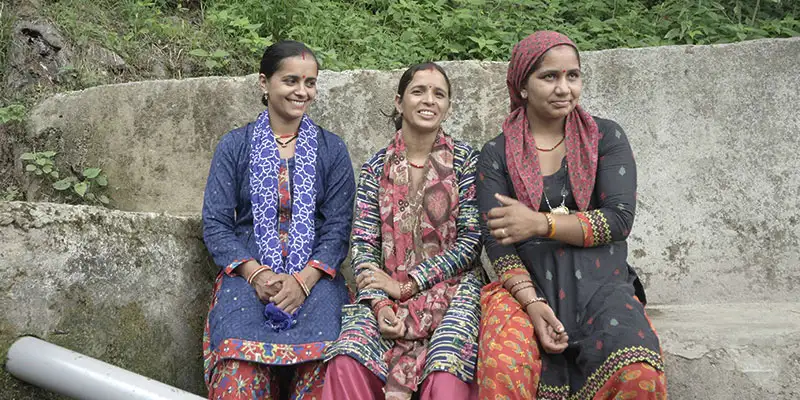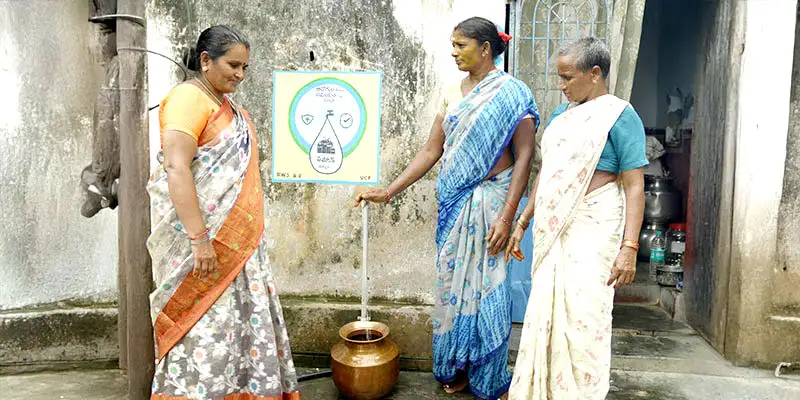An impact assessment report commissioned by Tata Trusts on the implementation of the Jeevan Jal Mission by the Trusts’ partners in six states highlights its transformative impact, analyses the challenges, and suggests a roadmap for sustainable water security in rural India
The Jal Jeevan Mission (JJM) was launched by Government of India in 2019 with the ambitious goal of providing Functional Household Tap Connections (FHTC) to every rural household by 2024.
The Tata Trusts partnered with the Government of India and state governments to provide technical and implementation support for the JJM in more than 2,000 villages across 12 states between 2021 and 2024. The Trusts, through its associate organisations as implementation partners, helped enhance community ownership of water assets by building capacity in Village Water and Sanitation Committees (VWSCs) for planning, implementation and operation & maintenance (O&M) of water resources under the JJM.
The Trusts have conducted an impact assessment of these JJM interventions in six states (in three regions) where its implementation partners have worked with state governments : Assam and Tripura (implementation support by the Centre for Microfinance & Livelihoods or CML), Karnataka (implementation support by Kalike), and Uttarakhand, Himachal Pradesh and Ladakh (implementation support by the Himmotthan Society).
The study highlights the areas of success of the JJM in significantly improving water accessibility, governance and community engagement across states. It also outlines the challenges that persist, and the roadmap ahead for sustainable water security in rural India.
Key achievements and impact
The JJM interventions have had multiple transformative impacts, as below:
Improved access: One of the JJM’s most significant achievements has been the expansion of FHTCs across states over the project period. In Assam and Tripura, the CML-supported intervention has provided access to safe drinking water to 39,619 households, improving availability to 55 litres per capita per day (LPCD) . Similarly, in Karnataka, Kalike has helped expand coverage to 19,500 households in 140 villages, benefitting 78,000 people. The FHTC coverage in the Karnataka region increased dramatically from 13% in 2021 to 88% by the end of the two-year project in June 2023.
Meanwhile, in the Himalayan states of Uttarakhand, Himachal Pradesh and Ladakh, the Himmotthan-Tata Trusts intervention benefited 31,371 households in 320 villages, with Leh achieving 100% household coverage of tap water post-intervention by the time the project culminated in October 2024.

Less time spent on collecting water: The reduction in time spent on fetching water has been another major success of the mission. In Karnataka, households that previously spent over 30 minutes to collect water, decreased from 41% at baseline to 27% at the end-line. In Tripura, 95% of women and adolescent girls reported significant relief from the drudgery of collecting water, allowing them more time for education and livelihood activities. Leh saw a similar trend, with 94% of households in end-line villages respondents now spending less than 30 minutes to collect water, as compared to 80% who previously spent up to an hour.
Reducing water contamination and disease burden: Water quality has also seen notable enhancements due to JJM interventions. The Trusts’ implementation partners have trained community members to monitor water quality using Field Testing Kits (FTKs), and installed Iron Removal Plants (IRPs) in high-contamination areas such as Tripura.
These efforts have contributed to a remarkable reduction in waterborne diseases. In Tripura, the incidence of such diseases dropped by 93%, while in Karnataka, villages with FHTCs reported a significant reduction in the disease burden. In Leh, the incidence of waterborne diseases among households declined from 4% to 1.3% after the interventions.

Empowering women to govern water resources: Community participation, particularly women’s leadership, has played a crucial role in sustaining these achievements. The formation of VWSCs has been instrumental in governance and oversight of water resources.
In Assam and Tripura, more than 50% of VWSC members are women, ensuring gender inclusivity in decision-making. Karnataka has established 140 VWSCs, empowering communities to take charge of water governance, while over 92% of households in Himachal Pradesh and Uttarakhand are now aware of their local VWSCs. By training women-led groups on water testing, maintenance and conservation, the Trusts have enabled them to play a more active role in decision-making processes related to water security.
Reinforcing impact: The Trusts’ implementation partners have undertaken various Social Behaviour Change Communication (SBCC) initiatives and financial sustainability measures to reinforce the JJM’s impact. They have conducted awareness campaigns, including wall paintings, street plays, and Information, Education and Communication (IEC) initiatives, in 80 villages in Assam and Tripura, while in Karnataka, they have held 560 training sessions on water conservation and hygiene.
Most villages in Tripura collect water tariffs monthly to ensure financial sustainability today, while villages in Leh and Himachal Pradesh have achieved 100% compliance on tariff collection, ensuring long-term maintenance of infrastructure.
Some challenges persist
Despite these significant advancements, several challenges remain. Geographical and climatic barriers pose difficulties in ensuring consistent water supply. In Tripura and Karnataka, remote and hilly areas experience supply issues, specifically during the summer season.
Infrastructure and maintenance gaps are another challenge. In Karnataka, some VWSCs faced funding shortages for maintaining resources, while in Tripura and Assam, regular technical training of pump operators is needed to ensure proper water supply management. Institutional capacity also needs to be strengthened further as some VWSCs lack clarity on their roles, leading to delays in addressing maintenance concerns. Additionally, it is essential to expand water-testing capabilities to ensure consistent monitoring of water quality.
Way forward: Strengthening water security
The impact assessment report outlines several strategies to address these challenges and ensure long-term water security. For one, it is crucial to strengthen the VWSCs’ capacity and governance by providing regular training on financial management, O&M and testing of water quality. Decentralising water governance and increasing the involvement of gram panchayats can also lead to better oversight and accountability.
It is also essential to enhance water quality monitoring by scaling up testing infrastructure and deploying more FTKs. The use of technology, such as IoT-based sensors for real-time monitoring of water quality, can further improve efficiency and enable early detection of water contamination. Developing climate-resilient water infrastructure, such as winter-proof pipelines in Leh and Ladakh to prevent freezing, and rainwater harvesting structures in regions that face seasonal water shortages, will also help mitigate the effects of climate change.
At the same time, community ownership and financial sustainability of water resources must be encouraged by expanding water tariffs and revenue models to sustain infrastructure investments. This includes conducting public awareness campaigns to enhance the acceptability of tariff-based models. Strengthening SBCC efforts by expanding school-based programmes to instil water conservation habits from an early age, and developing localised IEC materials will also be key in fostering long-term behavioural changes in communities.
Moving towards ‘Har Ghar Jal’
The JJM has achieved significant milestones in improving water accessibility, quality and governance across rural India. The Trusts’ impact assessment reports from Assam, Tripura, Karnataka, Himachal Pradesh, Uttarakhand, and Ladakh underscore the programme’s transformative power in community-driven water management. For India, sustaining and scaling these interventions will be essential to achieving universal water access.
Click here to read about the Integrated Drinking Water Project in multiple states in partnership with the Jal Jeevan Mission
